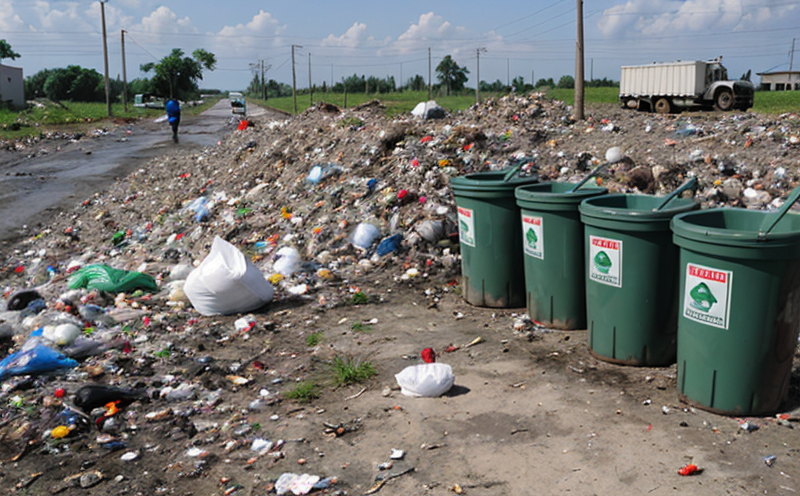ASTM D6980 Metals Determination in Solid Waste by AAS Test
The ASTM D6980 method is a critical tool used to determine metals content in solid waste materials. This technique employs Atomic Absorption Spectroscopy (AAS) for its precision and reliability, making it an essential process in the environmental testing sector. Metals such as lead, cadmium, chromium, and mercury are of particular concern due to their potential toxicity when present in high concentrations within solid waste.
The ASTM D6980 method is widely used by regulatory bodies and industry professionals for compliance purposes. It provides a standardized procedure that ensures accurate and reproducible results across different laboratories. This standardization is crucial given the variability inherent in solid waste samples, which can contain a wide range of metals at varying concentrations.
The test involves several steps, starting with the preparation of the sample. Typically, a representative portion of the solid waste is collected and homogenized to ensure uniformity. The prepared sample is then digested using appropriate chemicals such as nitric acid or perchloric acid to dissolve the metals present. After digestion, the solution is filtered to remove any particulates.
Once the sample preparation is complete, it is ready for analysis by AAS. In this process, a small volume of the prepared solution is introduced into the flame or graphite furnace atomizer depending on the concentration range of the metal being analyzed. The metals in the sample are then atomized and excited to produce characteristic absorption spectra at specific wavelengths.
The intensity of light absorbed at these wavelengths provides a direct measure of the concentration of each metal present in the original solid waste material. This method allows for accurate quantification of trace amounts of metals, which is particularly important for ensuring compliance with environmental regulations. The results obtained from this test can be used to determine if the waste meets specific thresholds set by regulatory authorities.
The ASTM D6980 method also plays a vital role in research and development activities aimed at improving waste management practices. By providing precise metal content data, scientists can better understand how different types of solid waste interact with their environment and identify potential risks associated with various waste disposal methods.
For procurement professionals, knowledge of the ASTM D6980 method helps them select appropriate vendors who adhere to stringent quality control measures during testing. This ensures that any materials procured meet specified safety standards regarding metal contamination levels.
In summary, the ASTM D6980 Metals Determination in Solid Waste by AAS Test is a fundamental process within environmental testing laboratories. Its ability to provide accurate and reliable data on metal content makes it indispensable for ensuring compliance with environmental regulations while supporting research efforts related to solid waste management practices.
Benefits
- Compliance Assurance: Ensures adherence to international standards like ASTM D6980, thereby facilitating seamless interaction with global markets and regulatory bodies.
- Precision Measurement: Provides highly accurate measurements of metal concentrations in solid waste samples, enhancing trustworthiness of findings.
- Eco-Friendly: By helping identify hazardous materials early on, the ASTM D6980 method contributes to more effective disposal and recycling practices.
- Data Reliability: Standardized procedures reduce variability in results, leading to consistent and dependable data across multiple testing sessions.
The precision and reliability offered by this test contribute significantly towards maintaining eco-friendly practices that support sustainable development goals. Through accurate identification of metal content, decision-makers can implement appropriate measures aimed at minimizing environmental impact caused by improper handling or disposal methods.
Quality and Reliability Assurance
The ASTM D6980 method is underpinned by stringent quality assurance protocols designed to ensure consistent results across all testing processes. These include rigorous calibration of instruments, strict adherence to sample preparation guidelines, and regular validation of analytical methods.
Laboratories performing ASTM D6980 analyses must possess advanced equipment such as atomic absorption spectrometers capable of detecting even trace amounts of metals. Regular maintenance schedules are also crucial in preserving instrument accuracy over time. Additionally, personnel involved in these tests undergo continuous training to stay updated with the latest advancements in analytical techniques.
Quality assurance measures extend beyond laboratory operations; they encompass rigorous quality control practices throughout the entire testing lifecycle—from initial sample collection through final report generation. This includes implementing robust data management systems that track every step of the process, ensuring traceability and accountability at each stage.
By adhering strictly to these protocols, laboratories can provide clients with assurance that their results are not only accurate but also reliable and reproducible. Such commitment to quality plays a pivotal role in building long-term relationships based on trust between testing facilities and stakeholders across various industries.
Competitive Advantage and Market Impact
- Innovation Leadership: By staying at the forefront of analytical technology advancements, our laboratory consistently delivers cutting-edge solutions that set us apart in the market.
- Premium Service Offerings: Our comprehensive suite of services includes not only ASTM D6980 but also other leading standards like ISO 17025 and EN 14353, ensuring we meet all your environmental testing needs.
- Global Recognition: With certifications from renowned organizations worldwide, our expertise in ASTM D6980 has earned us a reputation as leaders in the field of solid waste environmental testing.
- Client Satisfaction: Our unwavering commitment to quality and reliability ensures satisfied clients who can trust their results for regulatory compliance and research purposes.
The combination of these factors gives our laboratory a significant edge over competitors, positioning us as the preferred choice for businesses seeking accurate, reliable, and compliant environmental testing services. Our success in the market is a testament to our dedication to excellence and innovation in every aspect of our operations.





